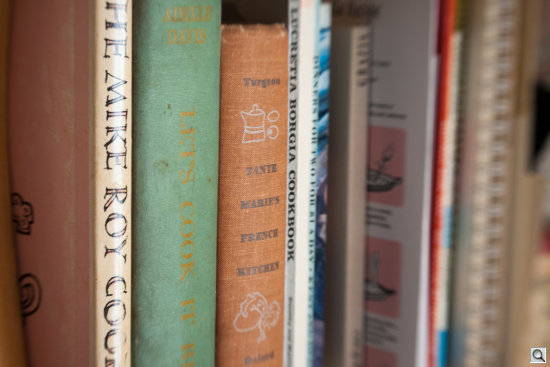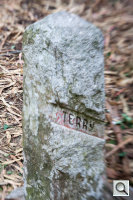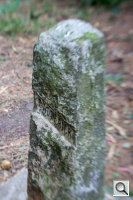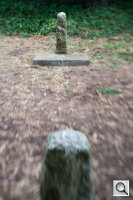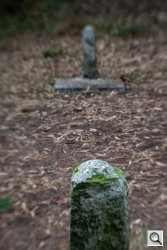CANON & NIKON MOUNTS
Lensbaby Spark Makes
Selective Focus Affordable
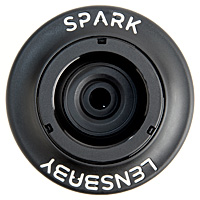
By MIKE PASINI
Editor
The Imaging Resource Digital Photography Newsletter
Review Date: September 2012
There was something vaguely familiar about the new Lensbaby Spark selective focus lens. We scratched our head a while before we made the connection. Instead of the swivel ball of recent models, this Lensbaby goes back to the bellows design of the Lensbaby 2.0.
Lensbaby Optics Reviews
Lensbaby Mounts Reviews
It isn't quite the same bellows. It's stiffer, for one thing. And Lensbaby hasn't forgotten its Optic Swap system. The Spark includes a multi-coated glass doublet optic and you can pop in other modules in the system. We tried the Fisheye optic, for example, and it worked just fine.
And the glass doublet isn't quite as elaborate as other modules. It doesn't have the internal apertures of the Sweet 35 and Edge 80 lenses or even the aperture disks of the standard modules. Instead it uses a fixed f5.6 aperture.
That's not too bad, we found, in practice. For one thing, it's bright enough to use either your LCD or optical viewfinder to focus without requiring you to use the LCD (which really wide apertures require). And for another, you can see the sweet spot pretty clearly.
The best thing about it, though, is that $80 price tag. That can put a clever selective focus optic into the hands of any Canon or Nikon dSLR owner.
SPECIFICATIONS | Back to Contents
The product specifications for the Lensbaby Spark are:
| • | Focal Length: 50mm |
| • | Aperture: fixed f/5.6 |
| • | Optic: multi-coated glass doublet |
| • | Focus type: manual |
| • | Sweet spot, selective focus lens (creates a sweet spot of focus surrounded by gradually increasing blur) |
| • | Available for Canon and Nikon mount dSLRs |
| • | Focusing range: approximately 13" (33 cm) to infinity |
| • | Compatible with Lensbaby Optic Swap System and all Lensbaby 37mm threaded accessory lenses (but see Macro Note below). |
Our review unit came with the assembled two-piece lens in a cloth bag. To remove the optic, you need a special tool, which comes as the cap of the case for accessory optic swap modules. So when you actually need the tool, Lensbaby will give it to you.
Spark is available now from amazon.com, select specialty photo stores worldwide and from Lensbaby.
Purchasing the Lensbaby Spark via the Imaging Resource Amazon affiliate program helps support reviews like this, by the way.
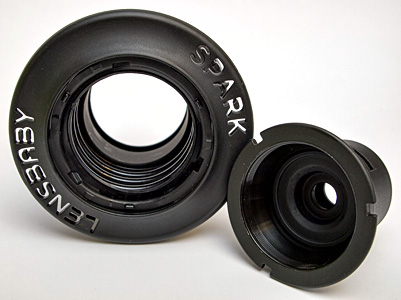
Two Parts. The housing with the bellows (left) and the multi-coated glass doublet optic.
WHAT IT DOES | Back to Contents
With the 50mm Spark, only a part of the scene is in focus (and we're not talking depth of field). You can move this circular sweet spot of focus up or down, left or right, even toward infinity or close-up by squeezing the bellows left, right, up, down, in or out. To focus up close, for example, push the flange out a bit.
The front flange of the Spark, with clever cut-outs for the company and product name, has been designed for you to get your fingers on it to do just that.
We had to rely on our right-hand pinky to work that side, since we were busy gripping the camera and fingering the Shutter button with our other fingers but it's workable.
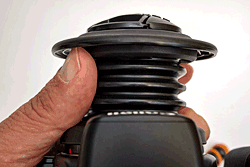
Selecting Focus. Push or pull the flange to move the focus spot around the scene.
As you manipulate the glass doublet optic by squeezing the bellows, you can follow focus in the viewfinder. This can be kind of fun. It isn't what you usually see through your viewfinder, after all. Instead, it's a little like aiming a spotlight on the important element of your scene.
And that's the fun of it, really. You explore the scene with focus yourself before deciding what to draw the viewer's attention to. Which is the creative part. In fact, "fun" and "creative" are two words you can expect to most find frequently used to describe the Spark.
"Spark sprouted from Lensbaby's fun and creative roots," said Craig Strong, Lensbaby chief creative officer and co-founder. "We crafted Spark for photographers who look to go beyond their predictable kit lens and experiment with visual spontaneity in-camera."
WHO IT'S FOR | Back to Contents
The price tag may suggest this is a toy, but it's not just for kids. In fact, we thought it would be the perfect lens for your older camera body, offering a unique special effects perspective for event photography, for example.
The effect is simply that it lets you pick someone out of the crowd. It separates that person from everyone else with focus. Might not be a bad tool for street photography but it isn't very stealth-like to be looking through the viewfinder.
We didn't have a dSLR body to try this with, but it certainly functions in video mode, too. You may have to rehearse to get the effect right, but it won't hurt to start with a blurry scene and discover what's in it by finding focus.
FINDING FOCUS | Back to Contents
Except for the glass in the optic, it seems to be made entirely of plastic (including the mount, but then so is our Canon kit lens) so it's surprisingly lightweight. And the big flange on the front makes it easy to use, too.
And that's lucky because with the bellows extended to its normal length, nothing at all is in focus. You have to start squeezing to see anything.
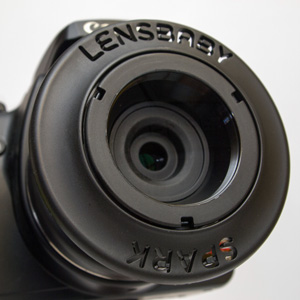
Mounted on a Canon Rebel |
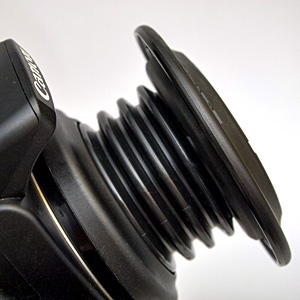
Side view |
|
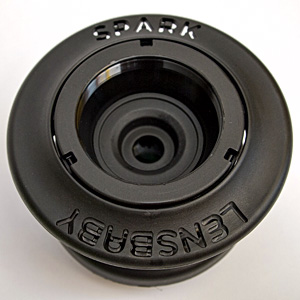
Front |
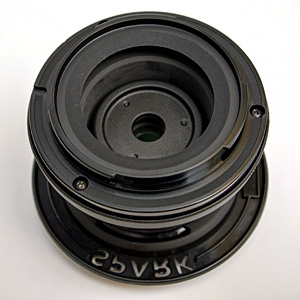
Rear (plastic mount) |
|
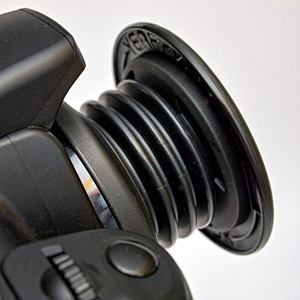
Shutter/flange distance |
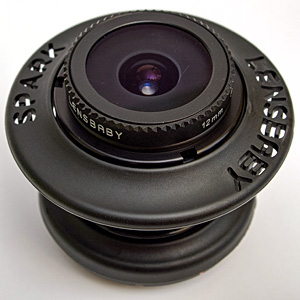
Fisheye optic in Spark |
Even then focus can be elusive. You'll see it pop and then disappear, partly because the bellows is so stiff but also because, with that constant tension, it's hard to hold position. Just as it was with the Lensbaby 2.0.
It's important to use that diopter on the viewfinder to make sure it's in focus itself or you can drive yourself nuts, by the way.
Sometimes we found focus more than elusive. On occasion it seemed impossible. Nothing in the scene seemed to be in focus. We think that's a little like what happens when you get a new pair of glasses and it takes a while for your brain to learn how to use them. The proof was in the images on the computer. The lens did find focus even if we didn't notice.
CAMERA SETTINGS | Back to Contents
With a fixed aperture lens, Program mode (not to mention any other Auto mode) isn't going to cut it.
Instead, set your camera to Aperture Priority mode. That tells the camera not to worry about the lens aperture, you've got that covered. It will concentrate on setting exposure by adjusting the Shutter speed. That works fine.
Don't forget to keep an eye on the ISO, too. On some cameras you set this to a fixed value as you might have with film (ISO 100 or 400 or 800) while on others, you can let it float within a range (ISO 100-400, 100-1600).
The only leg of the three-legged exposure "tripod" (aperture, shutter speed and ISO) that your camera can't adjust with the Spark aboard is the aperture.
A selective focus lens isn't just a special effect. Yes, it blurs most of the frame. And that qualifies as a special effect.

Sparked. Selective focus isn't always obvious. Here the f/5.6 aperture was enough to focus the whole sign in the middle of the image, leaving the background blurred.
But if that's all it did, you wouldn't be reading about it here. It would be useless. Who needs a lens that can't see straight?
In fact, though, a selective focus lens can see straight. But only a circle of the image is in focus. The size of that circle is determined by the aperture. And f/5.6 gives you a pretty obvious circle of focus to move around. Which is not so shallow a depth of field that you'll have trouble with common subjects.
When you present a perfectly focused landscape to a viewer, say on an 11x14 print, they have to explore the image for significance. When you present that same image taken with a selective focus lens to them, they immediately know where to look.
A selective focus lens, in short, adds a mind to the camera's eye.
To illustrate this, we took the Spark to the site of the last duel in California. There Senator David Broderick was mortally wounded by former Chief Justice of the Supreme Court of California David Terry.
The site has two pillars representing the dueling positions of each man. There used to be a plaque on the hill to the north of them indicating where the crowd stood. But only the pillars are left at the site itself. A few signs at more public locations point the way and tell the story.

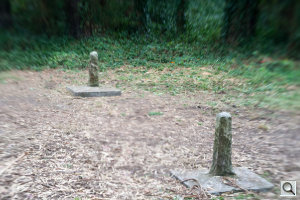
Distance. Selective focus wasn't as effective on blurring the near subject when focusing on the far subject (bottom), which is Broderick's pillar.
Nothing quite cries out for selective focus as a duel.
We were able to stand behind each pillar and focus on either the far pillar or the top of the near one. And the shift out of focus was dramatic, almost like light rays beaming from the circle in focus. Those beams were more out of focus the further into the scene you looked, too.
We were also able to stand at the side and focus on one or the other pillar. But when the second pillar was further away, the effect wasn't as noticeable. Then, too, a 50mm angle of view is barely wide enough to see them both from the side.
That's the obvious approach. But just photographing the pillars themselves is an excuse to be creative with focus. We shot the pillars focusing on the names (although, like Broderick, we missed Terry). And that's all that was in focus.
We didn't always hit the mark, as our example shots show, and it was sometimes hard to tell what was in focus and to hold that position while we pressed the Shutter button. But we had a pretty good batting average, only missing a few.
As we reported, we had trouble mating our 37mm Lensbaby macro converter lenses to the front threads of the review unit. But Lensbaby confirmed that the converter lenses should fit the optic. So we gave it another shot.
It wasn't easy but we did manage to barely thread the converter lens onto the optic. The converter lens seemed to sink a bit into the optic, as we had noticed, but by gingerly fiddling with the converter, we were able to engage the threads.
The connection wasn't very secure, though. A quarter turn and the converter lens popped right out.
Still, we were able to take a few macro shots and include them here. None of them required manipulating the bellows. The first was shot with the +10 converter and the others with the +10- and +4 both mounted together.
Update. Lensbaby replaced our original unit with a production Spark and we took a close look at the threads on both optics. What we found was that the original's threads started further into the barrel than the multi-coated glass doublet on the newer model. That made it hard to thread the macro lenses on the original, as we reported. But it's no trouble at all on the production model. It does indeed support 37mm accessories.
SOFTWARE SOLUTIONS | Back to Contents
With radial blurs and tilt-shift filters now common in image editing software, you might wonder if it wouldn't be easier to just take that approach with a straight shot using a normal lens.
And you can simulate the effect (even the gradually increasing blur) but we find when it was created in the camera it's a lot more dramatic. That may be because creating it at the scene is more engaging that dealing with a 2D fait accompli.
Then, too, it was a lot more fun to do it in the field than in a chair.
A Lensbaby for $80 can make your heart tweet. Especially when it's compatible with the Optic Swap system. If you want to explore other apertures, you can just buy an optic that uses discs.
Whether it's a gift or a new job for your old camera body, the Spark is a good deal. And that's worth a round of applause.
